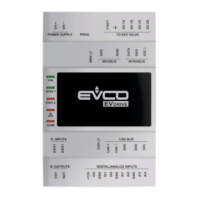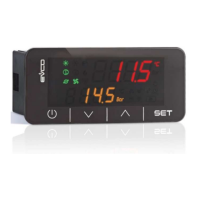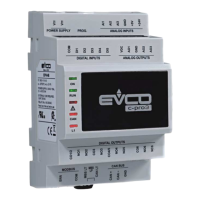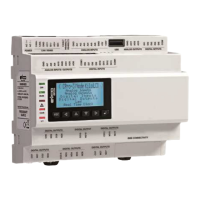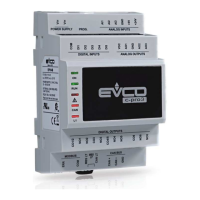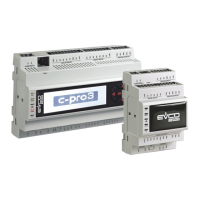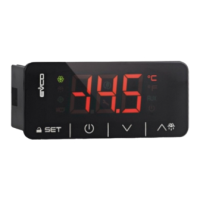EVCO S.p.A.
c-pro 3 nano CHIL | Application manual ver. 1.0 | Code 144CP3NCHE104
page 53 of 90
Awaiting switch-on: The compressor waits for the protection periods to elapse before switching on. The state display shows “ON”.
Off: The state display shows “OFF”.
Awaiting switch-off: The compressor waits for the protection periods to elapse before switching off. The state display shows “OFF”.
Alarm: The compressor is in alarm. The state display shows “ALARM”.
Manual: The compressor is in manual operating mode. The state display shows “MANUAL”.
In the maintenance operator menu, with parameters PM01, PM02, PM03, and PM04, you can read the number of operating hours of the
relative compressors. To zero out these hours, you can type the value “0” using the SET key.
8.7.2 Compressor Rotation
The rotation of the compressors is a procedure that allows for balancing – to the extent possible – of the number of operating hours
and start-ups of each compressor.
In the event of dual circuits, the rotation must balance the operating hours of both circuits. The rotation does not concern any
compressor in the state of alarm or manual operating mode, and can dynamically switch on other compressors if one or more
compressors should be in alarm state.
With parameter PC01, the programme can manage four types of rotation: FIFO, LIFO, FIFO + number of hours, LIFO + number of
hours.
1. FIFO
This method follows the “First In First Out” logic, that is, the first compressor that turns on must be the first to turn off. This operation
logic could initially entail a huge difference in the number of operating hours between the various compressors, but after the initial
phase, the hours should be more or less equal.
This type of rotation has a particular characteristic in cases when not all compressors configured in the system are on; in fact, if for
example you switch on and then the switch off the first compressor, the next compressor to switch on will be the second. The last
compressor to turn off is stored in the memory, then the next compressor in the sequence switches on in order to keep from always
using the same compressor, thus taking best advantage of all configured elements.
2. LIFO
This method follows the “Last In First Out” logic, that is, the last compressor to be SWITCHED ON will be the first to be SWITCHED
OFF.
3. FIFO + number of operating hours
This type of rotation favours comparison of the number of operating hours of the different compressors. Upon switch-on, the
compressor with the least number of operating hours will be given precedence, while upon switch-off precedence will be given to the
compressor with the greatest number of hours.
If it’s necessary to choose between compressors with the same number of operating hours, a FIFO rotation is activated to guarantee
rotation in any event, also in the presence of the same number of hours (see the FIFO case above).
4. LIFO + number of operating hours
This type of rotation favours comparison of the number of operating hours of the different compressors. Upon switch-on, the
compressor with the least number of operating hours will be given precedence, while upon SWITCH OFF precedence will be given to the
compressor with the greatest number of hours.
If it’s necessary to choose between compressors with the same number of operating hours, a classic LIFO rotation is activated.
On dual circuit machines you can decide – based on parameter PC02 – in what way the steps requested by the thermal control must be
shared by the two circuits:
PC02 = 0. Circuit balancing: the system requires one step per circuit alternately, so as to balance the loads between the two circuits,
as long as no alarms have gone off.
PC02 = 1. Circuit Saturation: the system requests all steps available from the first circuit, and then all those available from the
second circuit so that there is always a circuit with full load, as long as no alarms have gone off.
8.7.3 Pump-down Switch-off Procedure
On the machines with power supply above a certain limit and in which there is a substantial quantity of coolant, the pump-down
procedure is necessary to partially empty the evaporator of excess coolant. Thus, the solenoid valve located at the start of the relative
evaporator is controlled so that the compressor remains on for the time interval Compressor switch-off delay in pump-down (parameter
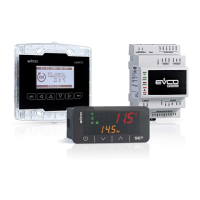
